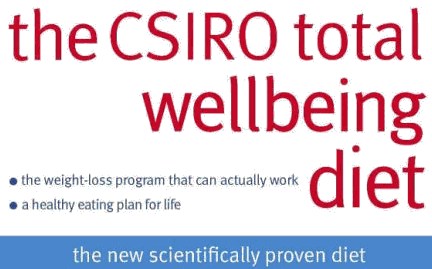|
Viewpoint-31 December 2005 |

|
CSIRO's Total Wellbeing Diet Stirs Unwelcome and Unnecessary Controversy |
 |
Photo credits: CSIRO
On December 22 the Journal Nature took note of the publication of The CSIRO Total Wellbeing Diet and questioned the appropriateness of the organisation lending its name to a book whose cover claimed, "The new scientifically proven diet." The cover also states, "the weight loss program that can actually work," and "a healthy eating plan for life."
Since its publication in May this year by Penguin, the 220 page $30 paperback, has sold over 550,000 copies in Australia and 100,000 in Britain and New Zealand. In 2006, it is expected to be translated into 13 European languages and will go on sale in the United States, Canada, India and South Africa.
By December 28 Nature's stinging criticism of CSIRO for associating itself with what it sees as an over-hyped commercial venture took the notice of Australia's mainstream media with Melbourne's The Age writing, "The book has sparked arguments in Australia between dieticians over its promotion of a high-protein diet at the expense of carbohydrates [,and] the fact that the book was funded by the meat and livestock industry [has] added to the controversy."
Jim Mann, from the University of Otago told Nature, "The hype goes beyond what the research proves," while Patrick Holford, from Britain's Institute for Optimum Nutrition, said he thought the diet was dangerous in the long term, possibly resulting in higher levels of breast and prostate cancer along with stressed kidneys and reduced bone mass.
Manny Noakes, one of the book's co-authors, has been designated by CSIRO to defend the organisation's decision to associate itself with the diet's popularisation. In fact she told The Age's Stephen Cauchi the decision to publish was not easy. "If we were going to publish a book, we would be on a shelf next to … really popular diets; we felt uncomfortable initially that we would be tarred with the same brush and it would look somewhat less than scientific." But then on Thursday she told the ABC that she believed the commercial success of the book had attracted the scathing review in Nature because "Whenever science goes into the public domain and becomes a commercial success, there’s always criticism from the establishment. Pushing the boundaries a bit in terms of what was considered to be mainstream advice is always going to be something that upsets the apple cart to a certain extent."
In a follow up published on Friday Cauchi reported, "the author of the CSIRO Total Wellbeing Diet has accused the prestigious science journal Nature of presenting a one-sided case against the diet in its critical editorial. She said she spoke "at great length" with the Nature reporter [Carina Dennis], but the journal chose not to publish her extensive rebuttals of the diet's critics. Only one quote of hers — "it's far more successful than we ever anticipated" — was published.
Dr Noakes went on to say, "It was clear the editor was pushing things in a particular way. I felt that I had answered all of the questions as best I could. We believe our particular perspective was not necessarily represented in the most objective way. That's most disappointing from a journal like Nature."
Let's now backtrack to the beginning of April last year.
On April 5, 2004 The American Journal of Clinical Nutrition received a a manuscript from Noakes, Keogh, Foster and Clifton titled, "Effect of an energy-restricted, high-protein, low-fat diet relative to a conventional high-carbohydrate, low-fat diet on weight loss, body composition, nutritional status, and markers of cardiovascular health in obese women."
It was accepted for publication on January 10, 2005 and published in the June 2005 issue of the journal.
A bit over 2½ months after receiving that paper, on June 25, 2004 the same journal received a second manuscript from Luscombe-Marsh, Noakes, Wittert, Keogh, Foster and Clifton titled. "Carbohydrate-restricted diets high in either monounsaturated fat or protein are equally effective at promoting fat loss and improving blood lipids."
It was accepted for publication on November 23, 2004 and published in the April 2005 issue of the journal, two issues before the Noakes, et al. paper.
Both papers state, "None of the authors had a conflict of interest". However, in the paper submitted on April 5, and the one cited in Appendix 4 of the The CSIRO Total Wellbeing Diet "for the full study method and results" it is acknowledged that the second author, Jennifer Keogh, was "Supported by a Medical Research grant from Meat and Livestock Australia".
In the case of both studies the timeframe was 12 weeks. And in the paper cited in the "Total wellbeing Diet" the subjects were all overweight or obese women whereas in the second paper (submitted June 25, 2004) both obese men and women were studied.
The columns below show the abstracts from the two papers.
| Effect of an
energy-restricted, high-protein, low-fat diet relative to a conventional
high-carbohydrate, low-fat diet on weight loss, body composition,
nutritional status, and markers of cardiovascular health in obese women Manny Noakes, Jennifer B Keogh, Paul R Foster, and Peter M Clifton |
Carbohydrate-restricted diets high in either monounsaturated fat or
protein are equally effective at promoting fat loss and improving blood
lipids |
|
ABSTRACT Background: Limited
evidence suggests that a higher ratio of protein to carbohydrate during
weight loss has metabolic advantages. Objective: The objective
was to evaluate the effects of a diet with a high ratio of protein to
carbohydrate during weight loss on body composition, cardiovascular
disease risk, nutritional status, and markers of bone turnover and renal
function in overweight women. Design: The subjects
were randomly assigned to 1 of 2 isocaloric 5600-kJ dietary interventions
for 12 wk according to a parallel design: a high-protein (HP) or a
high-carbohydrate (HC) diet. Results: One hundred
women with a mean (±SD) body mass index (in kg/m2) of 32±6 and
age of 49±9 y completed the study.
Weight loss was 7.3±0.3 kg with both diets. Subjects with high serum triacylglycerol (>1.5 mmol/L) lost more fat mass with the HP than with
the HC diet ( Conclusion: An energy-restricted, high-protein, low-fat diet provides nutritional and metabolic benefits that are equal to and sometimes greater than those observed with a high-carbohydrate diet.
Am J Clin Nutr 2005;81:1298 –1306. |
ABSTRACT Background: When
substituted for carbohydrate in an energy reduced diet, dietary protein
enhances fat loss in women. It is unknown whether the effect is due to
increased protein or reduced carbohydrate. Objective: We compared
the effects of 2 isocaloric diets that differed in protein and fat content
on weight loss, lipids, appetite regulation, and energy expenditure after
test meals. Design: This was a
parallel, randomized study in which subjects received either a low-fat,
high-protein (LF-HP) diet (29±1% fat, 34±0.8% protein) or a high-fat,
standard-protein (HF-SP) diet (45±0.6% fat, 18±0.3% protein) during 12 wk
of energy restriction (6±0.1 MJ/d) and 4 wk of energy balance (7.4±0.3 MJ/d).
Fifty-seven overweight and obese [mean body mass index (in kg/ m2):
33.8±0.9] volunteers with insulin concentrations 12 mU/L completed the
study. Results: Weight loss
(LF-HP group, 9.7±1.1 kg; HF-SP group, 10.2±1.4 kg; P 0.78) and fat loss
were not significantly different between diet groups even though the
subjects desired less to eat after the LF-HP meal (P 0.02). The decrease
in resting energy expenditure was not significantly different between diet
groups (LF-HP, -342 185 kJ/d; HF-SP, -349 220 kJ/d). The decrease in the
thermic effect of feeding with weight loss was smaller in the LF-HP group
than in the HF-SP group ( -0.3±1.0% compared with -3.6±0.7%; P=0.014).
Glucose and insulin responses to test meals improved after weight loss (P<0.001) with no significant diet effect. Bone turnover, inflammation, and
calcium excretion did not change significantly. Conclusion: The magnitude of weight loss and the improvements in insulin resistance and cardiovascular disease risk factors did not differ significantly between the 2 diets, and neither diet had any detrimental effects on bone turnover or renal function.
Am J Clin Nutr 2005;81:762–72. |
Several minutes spent reading through the carefully crafted abstracts of the two papers is rewarding. The principal analysis, on which the CSIRO diet is based (abstract on the left) shows a significant difference between the high protein / low carbohydrate vs the low protein / high carbohydrate diet in weight loss (P=3.5%) and diminution of serum triacylglycerol concentration (P=2.3%) but only in the group that showed initial serum triacylglycerol levels above 1.5 mmol/L. That is the only consequential difference between the two diets.*
On the other hand that work abstracted in the right panel was performed on a mixed group of obese men and women and held carbohydrate content constant while regimes of high protein-low fat or high fat - low protein were analysed. The data show no significant difference in weight loss between the two diets.
Overall then, with the one exception of obese women with serum triacylglycerol concentrations above 1.5 mmol/L, the data are consistent with the conclusion that weight loss is dependent primarily if not solely on the caloric intake.
In the issue that the paper of Noakes, et al. appeared J.O. Hill in his editorial refers to the work (but without mentioning the paper published previously in the April issue of the journal) observing:
Many different types of diets can produce substantial weight loss in the short term. Most obese persons attempting to lose weight do not fail in losing the weight but rather fail in maintaining the weight loss. We need to know whether high-protein diets are just alternative ways for some people to achieve weight loss (and probably gain it back) or whether they may be useful over the long term. We need research studies to answer at least 2 important questions: 1) Can high-protein diets be maintained permanently? and 2) Can high-protein diets help persons to permanently maintain their weight loss and the metabolic improvements they achieve? Answering these questions will require studies that focus not just on weight loss but on the long-term maintenance of weight loss. These studies will be difficult and expensive to conduct; however, without them we cannot provide the best advice on which diet is best for weight maintenance and whether the best diet for weight-loss maintenance varies from person to person.
The second message from the study of Noakes et al is that it may be possible to identify patients who will respond particularly well to high-protein diets. It is logical and intriguing to think that we can maximize weight loss by matching patient to diet, even though we have little past success in doing so. Noakes et al speculate that the reason why their subjects with high triacylglycerol concentrations responded better to the HP diet was because they were insulin resistant and that insulin-resistant patients may do better with HP diets... the best diet for maintaining weight loss may be different from the best diet for achieving weight loss. It is also important to evaluate whether matching patient to diet will not only help maximize weight loss during the consumption of hypocaloric diets but will also help maintain weight loss.
The question remains as to whether high-protein diets are a temporary tool for helping some people maximize weight loss or whether they represent a reasonable way for some people to eat permanently? The study by Noakes et al is a good start in addressing this question, but we must invest in long-term research studies to obtain a definitive answer.
So, returning to the opening sentence of this "Viewpoint" how appropriate is it for Australia's premiere research organisation to have its name on the cover of The CSIRO Total Wellbeing Diet thereby endorsing statements such as
"the new scientifically proven diet"
"the weight loss program that can actually work"
"a health eating plan for life"
which appear on the cover below the title.

It's unlikely that The CSIRO Total Wellbeing Diet will cause significant harm to the world's population, human or otherwise (fad diets come and go), but as to its effect on CSIRO's standing within its cohort of scientific institutions or its reputation with Australians per se, that's a more moot issue.
While we have no knowledge as to the events which led to the book's publication, it seems at least plausible that the decision to go "commercial" came from the organisation's administration rather than the scientists who undertook the research. And at the time the book was released in May 2005 were the authors, or any other individuals from CSIRO or Penguin involved in the publication of the book, aware of the caveats that would be published in Dr Hill's June editorial, i.e. the same issue in which the paper by Noakes, et al. was published?
Currently who was involved in negotiations between the organisation and the publishers, Penguin, and at what level(s) it was approved, is not public knowledge, although it is more than likely that it will become the subject of questions at the next session of Senate Estimate hearings.
Alex Reisner
The Funneled Web
*High levels of triglycerides are usually considered to be those above 2.3 mmol/L. However, some recent studies indicate this cut off point for deciding on treatment for coronary heart disease may lead to exclusion of some patients at risk.
The National Heart Foundation recommends that the level of triglycerides in the blood should be less than 2 mmol/L if you are considered to be at risk of coronary heart disease. This target may be different for people at lower risk of heart disease.
In their discussion the authors speculate about the correlation of weight loss in their high protein / low carbohydrate diet to serum triglyceride concentration but reach no definitive conclusion.